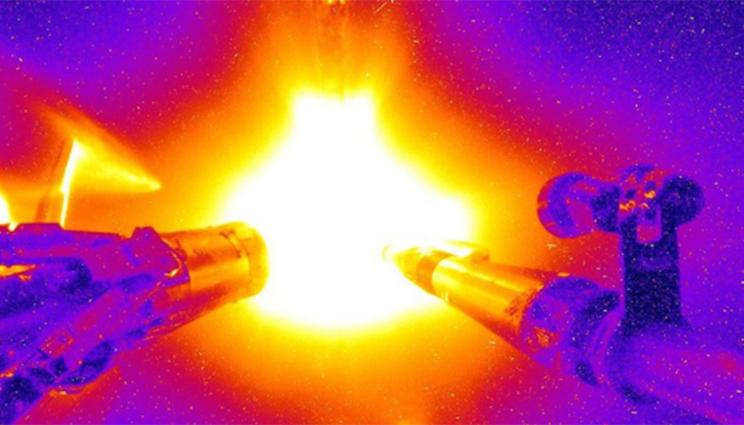
This colorized image of a National Ignition Facility "Big Foot" deuterium-tritium implosion was taken on Feb. 7, 2016. Experiments like this were highlighted as bright spots over the past 10 years in the Plasma Science Decadal Report.
The National Academy of Sciences, Engineering and Medrhicine released an assessment of the state and future of plasma sciences last month. Commissioned by the Department of Energy, the National Science Foundation, the Air Force Office of Scientific Research and the Office of Naval Research, the report outlines recommendations for the advancement of plasma science and is anticipated to help set the direction for the field over the coming decade.
Lawrence Livermore National Laboratory (LLNL) physicist Gail Glendinning served on the 18-member committee that produced the 291-page report, leading the section focused on high energy density (HED) plasmas. Over the course of a year and a half, committee members drew on input from researchers across the country on the topics of: HED plasmas, laser/plasma interactions, magnetic fusion, basic plasma physics, astrophysical plasmas and low-temperature plasmas. Multiple LLNL researchers provided input through white papers and participation in information-gathering town hall meetings.
The report identified six grand challenges for plasma science over the coming decade, four of which relate to research conducted at LLNL: understanding the behavior of plasmas under extreme conditions; mastering the interactions of the world's most powerful lasers and particle beams with plasmas; accelerating the development of fusion generated electricity; and demonstrating that lasers and pulsed-power devices can produce inertially confined fusion ignition.
It also recommended a national strategy to develop new classes of laser systems and called for increased support of plasma science research at universities to foster diversity and prepare a new generation of graduates to conduct research using the most energetic experimental drivers at national laboratories, like the National Ignition Facility (NIF) at LLNL.
"The whole field is aging, and plasma physics is one of the least diverse branches of physics," said Glendinning, who was one of the committee members that produced the report. "We recognized that universities are training grounds. They will play a crucial role in encouraging an interest in plasma science among underrepresented populations and fostering more diversity in the field."
Fifteen mid-scale laser facilities are currently in use across U.S. universities, giving students the opportunity to conduct fundamental plasma science research while also preparing them for larger laser facilities, like NIF. However, Glendenning noted that a gap exists across the country in terms of mid-energy pulsed power research capabilities. There are only a dozen small-scale pulsed power facilities across U.S. universities and none at the mid-scale.
"It's important that the country work to create and sustain high energy density pulsed power facilities at universities to train the workforce and study physics relevant for the next big drivers," Glendinning said. "Such stepping-stone facilities, the report finds, are key to preparing the next generation for important national security research at national laboratories."
NIF was prominently featured in the report as the source of multiple breakthroughs over the past decade in the area of HED plasmas. As the most energetic laser system on Earth, it enables researchers to put plasmas under extreme conditions relevant to understanding the conditions only found in stars, massive planets and nuclear detonations. It has become an indispensable element of the Science-Based Stockpile Stewardship Program, as well as a pair of programs led by LLNL to modernize aged nuclear warheads. In particular, the report cited that NIF has enabled significant new understanding of the plasma physics required for ignition and has provided data essential to stockpile stewardship, even without ignition.
"It was great to see that this NAS report recognized the importance of high energy density science and laser plasma interactions to the field of plasma science," said Mark Herrmann, NIF director. "I particularly appreciated the praise for the quality of science being done by Lab scientists and other users of the NIF. The NAS study also set forth a series of exciting grand challenges for our field, many of which are closely tied to the work we are doing at LLNL to ensure our national security."
In order for the nation to continue to lead in plasma science and tackle these grand challenges, the report called for a national commitment to build the successors to today's largest experimental capabilities.
"While the existing major facilities are expected to continue to produce scientific advances for at least the next decade, planning for the next generation of ICF and HED facilities, both laser- and pulsed-power-driven, is beginning," the report stated. "If the United States is to continue as the international leader in ICF (inertial confinement fusion), the next HED facility intended for ignition must be designed and built."
The national laboratories are home to the largest experimental drivers on Earth. Sandia National Laboratory is home of the Z-machine, the largest pulsed-power capability, and LLNL is home to NIF, the most energetic laser system. Both have become indispensable elements of stockpile science.
"It was an honor to be part of this assessment of the state of plasma physics," Glendinning said. "I'm sort of nearing the end of my career here after 35 years, and I saw this as a way to make a contribution and possibly help provide direction for the future. I think it's important that we find ways to do more HED physics at universities and continue pushing the envelope with the next generation of large experimental drivers. If those are outcomes of this report, then I think that would be very impactful for the nation."






